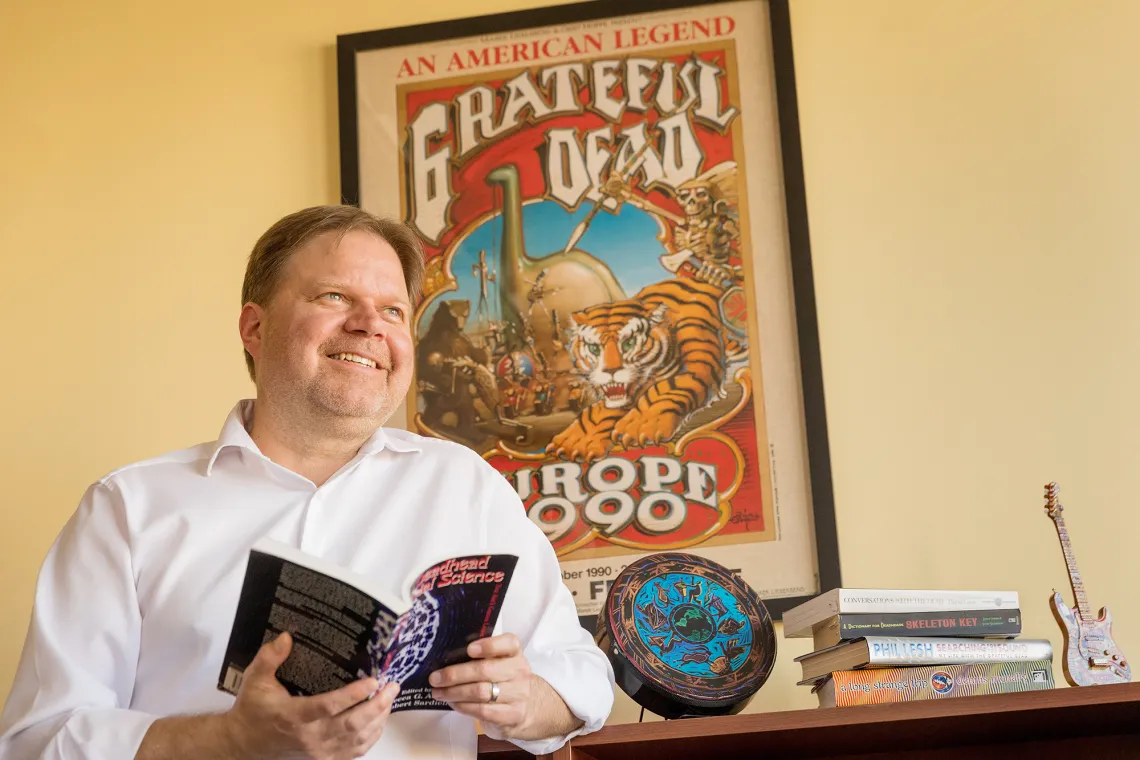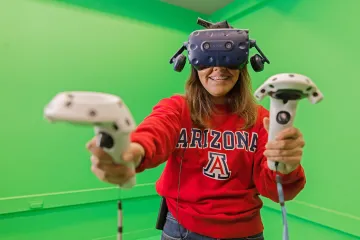The Dean and the Dead
A new era of successful, bold, imaginative graduates

'We want to up our game so the libraries can be a central hub,’ Shan Sutton says, ‘where our students are becoming these creative, innovative problem solvers outside the formal classroom using creative technologies to build on what they are learning in the classroom.'
Never underestimate the Grateful Dead.
For decades, their eclectic rock songs — like 1970’s “Truckin’” — and far-out technology inspired innovation across American music as they engineered a dazzling new Wall of Sound for concerts and a ticketing system operated by the band’s staff.

The iSpace will be part of the CATalyst Studios at the Main Library, where students are encouraged to collaborate across disciplines and explore new technologies.
Today, at the University of Arizona, the Dead’s spirit is helping drive one of the most radical campus technology waves ever. Almost 25 years after the band broke up, Dean of Libraries Shan Sutton ’96, who holds an endowed chair and happens to be a lifelong Deadhead and scholar of the Grateful Dead, is spreading the Woodstock-era band’s spirit as he expands students’ horizons.
On his arrival in 2015, Sutton says that he began to think, “The kind of mindset we are trying to develop in these students really reminds me of the mindset I saw in the Grateful Dead.
The idea is that you create your own solutions to problems — that you don’t accept the status quo if the status quo doesn’t meet your needs.”
Look around at students flocking into UA Libraries, turning on gadgets like a 3D printer, a Raspberry Pi (a tiny programmable computer), virtual reality gear and even a new Singer sewing machine. You’ll sense that Sutton is just gearing up for this trip with campus technology.
Recently, an engineering class filled the noisy Collaborative Learning Space at the Albert B. Weaver Science-Engineering Library. At each of 25 round tables, three to six students debated, brainstormed and dug online for original solutions to a problem. This was a session of Electrical and Computer Engineering 175.
Next up in the same room was physiology. Chemistry and psychology were on deck. Nearly 2,000 students a day use this facility, which is the largest collaborative learning space on campus. Professors join students at the tables and talk with each team. “As a guide on the side, not a sage on the stage,” Sutton says.
Down the hall, one student brought his senior project idea to the iSpace, a library room packed with technology, equipment and supplies. Scott Omo, a junior in mechanical engineering and a student worker at the library, helped the student use the 3D printer to make an original valve for a shipping container.
That lowercase “i” in iSpace might be for “information” or “internet.” Or it could be for “imagination,” says Omo.
“It just depends.”
An art student asked Omo for help with laser-cutting an acrylic structure. Done.

UA Libraries offers the university’s first public Virtual Reality Studio, which students can use for work or play.
In the same makerspace, a student was learning to hem his jeans with the sewing machine. Another student showed up with a dress she wanted to redo as a pantsuit.
It all reflects a creative spirit that Sutton connects to the Grateful Dead, rock ‘n’ roll’s disruptive problem solvers.
Sutton delights in recalling his own college days, traveling with the hordes of Dead fans and listening to the guitar work of Jerry Garcia.
His research on the Dead as radical thinkers feeds into his dreams of creating successful, bold, imaginative graduates and making the UA a world pacesetter in reshaping tools and culture for students.
At Wright State University, Sutton wrote a master’s thesis on the Grateful Dead as a vehicle for the pursuit of mystical experiences through ritual structures paired with improvisation. His work was published as a chapter in the book “Deadhead Social Science: ‘You Ain’t
Gonna Learn What You Don’t Want to Know’” (Altamira Press, 2000).
He explains how, during concerts, Dead followers floated into “the moment” of “unrehearsed, improvised experiences — on the fly,” and later retreated back to their everyday roles, where they could apply the knowledge gained. “It’s a powerful model to study, pulling from different disciplines,” he says. “It was exciting and transformative for the audience.” He should know. He’s attended 83 Dead shows and readily cites examples of the band’s innovation from technological advances in equipment to creating a taper section in the audience.
Sutton, now 50, dreams of UA students soaring like the Grateful Dead community, immersed in new ecosystems, creating their own future with new paradigms.
His career in libraries took him from a master’s in information and library science from the UA to the University of the Pacific and Oregon State University. He returned to the UA four years ago. Here, he’s been involved in planning the Student Success District project, a joint project of UA Libraries and the Office of the Provost.
“The UA is really committed to developing students who can bring a critical thinking mindset to their work, who are innovators, who are disruptors because they think there’s a better way to do things,” Sutton says.
“We want to serve students who are focusing on problem solving — who are learning by doing, by creating, by applying knowledge rather than just memorizing knowledge.
“And I ask, ‘How can the libraries be a central player to develop these kinds of students?’”
“We want to up our game so the libraries can be a central hub,” Sutton says, “where our students are becoming these creative, innovative problem solvers outside the formal classroom using creative technologies to build on what they are learning in the classroom.”
And, of course, they can use the UA Libraries’ 8.5 million print and electronic books and journals as well as the library buildings that attracted 2.5 million visitors in 2018.
“Expertise with technology and working effectively in groups is absolutely mandatory in today’s workplace,” Sutton says. “We think it’s a springboard into great jobs and creating a better future.”
The Grateful Dead would agree.
